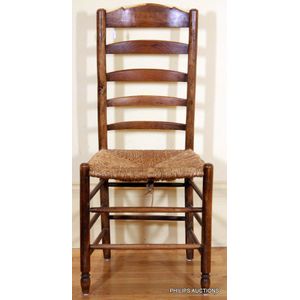Huanghuali Spindle Bench with Galleried Apron
You must be a subscriber, and be logged in to view price and dealer details.
Subscribe Now to view actual auction price for this item
When you subscribe, you have the option of setting the currency in which to display prices to $Au, $US, $NZ or Stg.
- Patination / Patina - In broad terms, patination refers to the exterior surface appearance of the timber, the effect of fading caused by exposure to sunlight and air over the course of a century or more, changing the piece to a soft, mellow colour.
As patina is very difficult to replicate, it is one of the most important guides to determining the age of furniture.
Patina is also the term applied to the bloom or film found on old bronzes due to oxidisation. - Ming Dynasty - The Ming Dynasty was a ruling dynasty of China from 1368 to 1644. It succeeded the Yuan Dynasty and preceded the Qing Dynasty. The Ming Dynasty was established by Zhu Yuanzhang, a former Buddhist monk who became a rebel leader and eventually overthrew the Mongol Yuan Dynasty. During the Ming Dynasty, China experienced a period of relative stability and prosperity. The government was centralized and bureaucratic, with the emperor at the top of the hierarchy. The Ming Dynasty is known for its cultural achievements, including the development of porcelain, the invention of movable type printing, and the construction of the Great Wall of China.
- Qing Dynasty - The Qing Dynasty was the last imperial dynasty of China, ruling from 1644 to 1912. It was established by the Manchu people, who originated from the northeastern region of China. The Qing Dynasty was preceded by the Ming Dynasty and followed by the Republic of China.
- Huanghuali Wood - Huanghuali is the most sought-after timber used in the construction of Chinese furniture because of its fine colour and grain.
During Ming and early Qing dynasties, most of the best furniture was made from huanghuali wood.
It is a member of the rosewood family and over time the surface mellows to a yellowish brown tone with the exposure to light.
In recent years, furniture made from huanghuali wood has increased exponentially in value.
This item has been included into following indexes:
Visually similar items

A Chinese rosewood spindle back bench, Qing Dynasty, the grain & colour very similar to huang huali. Provenance: From a collection assembled in the 1980s, condition: some fading in parts, height 81 cm, length 106 cm, width 46 cm

Grete Jalk [attributed], teak three seater sofa and matching armchair, with paddle shaped arms on cylindrical tapering legs

A set of four Chinese elm chairs, a variant on the traditional scholar's chair with squared backs and camel hump crests, tapering reeded splats to mitred seats, a waisted section above four straight legs united by box stretchers, height 96 cm, width 48 cm,

An antique oak ladder back chair, late 19th century, the square back chair with cylindrical supports, an arching crest and graduated mid-rails, a rush seat to legs with turned feet and united by multiple turned box stretchers. Height 111 cm, width 51 cm, d
